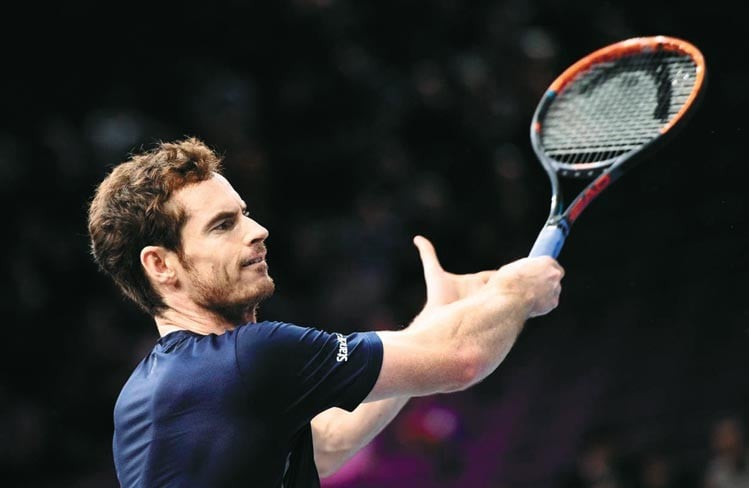
In the toughest era in the history of tennis, the fact that Andy Murray managed to be the year-ending World No 1 in 2016, would be acknowledged as one of the greatest sporting achievements of all time

If you bet a few bucks on none of Roger Federer, Rafael Nadal and Novak Djokovic winning the ongoing Australian Open, you can multiple your investment by manifold - if such an oddity does transpire. The trio, firmly on the other side of 30, remain the overwhelming favourites for any major they enter.
The three maestros collectively won all of the eight majors in 2017 and 2018. With Federer at 20, Nadal at 17, and Djokovic and 14 slams, the three rank as the most decorated players of all time, with the debate now moving to just how many each of them will end up with.
Just to put things into perspective, since Marat Safin won the Australian Open in 2005, The Big Three have won 47 out of the 55 majors.
Of the remaining eight, Andy Murray has won three. He made eight other Grand Slam finals. Murray also won 14 ATP Masters 1000 titles, which place him fifth after the Big Three and Andre Agassi on the all-time list.
The Brit also has two Olympic Gold medals, which no other male tennis player has. The Olympic Gold in singles is the coveted piece of silverware - available, of course, once every four year - which even the likes of Federer and Djokovic don’t have in their glittering trophy cabinets.
It is those Olympic Golds, the ATP Masters 1000 titles, the majors and all those finals, which for a decade pushed that Big Three to be known by the more widely prevailing name: Big Four.
Around the turn of the decade, Federer and Nadal were the leading forces in men’s tennis, with Djokovic and Murray being the challengers. Djokovic’s groundbreaking 2011 season looked like distancing the Serb from the Brit, but then Murray broke his Grand Slam duck at the US Open 2012 - beating Djokovic in the final. He would win his second major, and first Wimbledon in 2013, beating the Serb in the final again.
Djokovic reached new heights again in 2015-16, when he held all four majors after winning Roland Garros 2016, but Murray would go on to have an unparalleled second half of the season - including a second Wimbledon and the World Tour Finals - to end the year as the World No. 1.
In the toughest era in the history of tennis, the fact that Murray managed to be the year-ending World No 1 in 2016, would be acknowledged as one of the greatest sporting achievements of all time. Let’s not forget that Murray topped the rankings at a time when Djokovic had fulfilled the biggest accomplishment in tennis, and Fedal were on the brink of their major winning resurgence in early 2017.
In an emotional press conference as the start of the ongoing Australian Open, Murray hinted that he might be on the verge of retirement and that this year’s Wimbledon could be his last tournament. The Brit bowed out of the first major of the year in typical gritty fashion after coming back from two sets to love down against Roberto Bautista Agut, before eventually running out of gas and succumbing to deteriorating fitness levels, which actually is the reason why he might soon be bidding adieu to the sport.
By the time this generation hangs up the raquets, beginning with Murray, it would be firmly acknowledged as the era of the Big Three - as far as the numbers are concerned. But for those of us who’ve witnessed this golden decade of tennis, a Murray enforced ‘Big Four’ will always be a glowing shade reality.
After all, while Murray has half the ATP 1000 titles as Federer - who is third on the all-time list behind Nadal and Djokovic - and a fifth of Djokovic’s Grand Slam titles - who is third on the majors’ list, the Brit will forever have impacted where these three eventually end up on the count of trophies and the scale of greatness.
It was Murray who denied Federer his best shot at Olympic Gold in the 2012 final. He’s also beaten the great Swiss at two ATP 1000 finals in 2010 at the Canada and Shanghai Masters.
The Brit beat Djokovic in the finals of US Open 2012 and Wimbledon 2013. He’s also beaten the Serb in ATP 1000 finals at Cincinnati (2008, 2011), Miami (2009), Canada (2015) and the World Tour Finals 2016.
Despite their 24 meetings, Murray and Nadal have surprisingly never met in a major final. However, the Brit denied the Spaniard an ATP 1000 title at the Madrid Masters 2015. Murray also knocked Nadal out in the quarterfinal in the US Open 2008 semifinal, when the Spaniard was looking to become the first man to win three consecutive majors on three different surfaces and then at the Australian Open 2011 when he was bidding to hold all four majors at the same time.
Each of Murray’s eight Grand Slam final losses have come against either Djokovic (5) or Federer (3). Meanwhile, he’s won two majors, one Olympic Gold, one ATP World Tour Final, and seven ATP 1000 Masters by beating one of the Big Three in the final.
And these are just the finals. Murray has a total of cumulative 29 wins against the Big Three - miles ahead of anyone else.
However, Big Three they shall be when it’s all said and done - not just of this era, but of all time.
While there might be a perpetual debate over which of Federer, Nadal and Djokovic is the greatest of all time (GOAT), having achieved so much in the undisputedly greatest ever era, Murray might be etched in history as the greatest challenger of all-time - the champion who challenged, and sometimes overcame, the greatest.